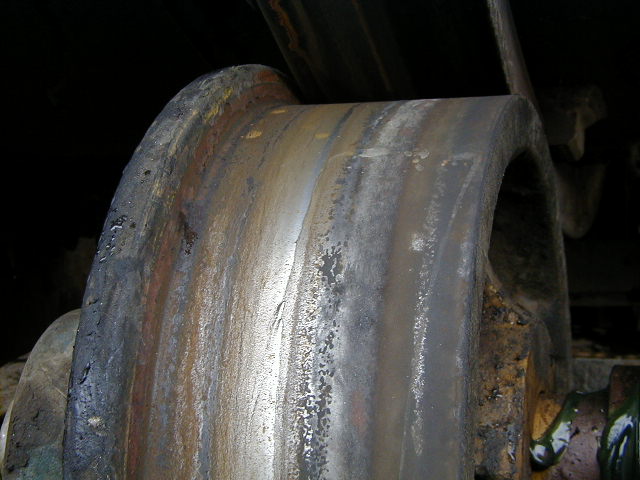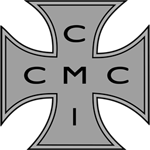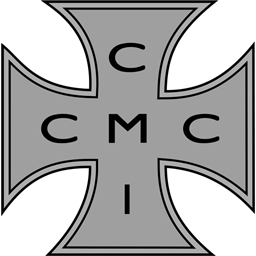In an earlier article I talked about drier/mixer trunnion adjustment procedures. If followed, these procedures can go a long way toward restoring the functionality of your drier/mixer, hereafter referred to as the drum. There are instances, however, in which no amount of adjusting will correct the problems exhibited by a particular drum. Sometimes, the trunnions and tires are simply too worn to do their job or the tires are scalloped so badly that the drum vibration is excessive. Wear is the most common problem.

Badly worn trunnions like this one can be ground flat again.
This was the situation I encountered in early February at Blythe Construction’s Plant 3 in Pineville, North Carolina. The plant manager, Punkin Sowell, contacted me as a result of that article in the spring issue. His crew was not having much success adjusting the trunnions on the plant and he felt that I might be able to help them. I flew to North Carolina to inspect the problem and recommend corrective measures.
The plant, a Gencor 400tph drummer, produces nearly 350,000 tons of hot mix per year and is well maintained and operated. My initial inspection revealed some moderately worn trunnions and tires. As can be seen in photo # 3, the discharge end trunnions were worn concave while the tire was worn convex. The result of this was that the drum was forced to try to climb out of a ‘dish’ in the trunnion surfaces. The drum would climb the trunnion until gravity exceeded traction, then the drum would slide back to its starting position and the process would begin again. When tire/trunnion surfaces are worn to this point no amount of adjustment is going to make the drum run correctly.
The burner end tire/trunnions exhibited a different problem. The surface contact was forced to the extreme downhill edge of both units. This was a result of the trunnions being too close together. Apparently, at some point in the past, someone decided that the drum needed more slope. Instead of shimming the drum frame as recommended, they moved the trunnions closer together which raised the burner end of the drum and caused the tire to ride at a bit of an angle to the trunnions thereby preventing full surface contact. Over time the tire/trunnions wore at the angle evident in the photographs.
When confronted with components worn to the degree that these were, most companies would have shut down the plant and replaced both tires and all the trunnions. The considerable cost of the parts is a minor consideration when compared with the resulting lost production. Taking this into consideration, I suggested to Jim Rynkewicz, Blythe’s equipment manager, that we build a machine, set it up and grind his trunnions and tires flat. I told him that we could do it without interfering in on-going plant operations, a real plus for a plant producing over 1,500 tons a day. After estimating the costs and considering the alternatives he agreed to the plan.
Our first mission was to find some method of holding a grinder stable while passing it evenly across the surface of the trunnions. For this job we purchased a compound milling table, part # 6Z849, from Granger for $249.00. We then mounted it on a 1″ thick steel plate which we clamped to the drum frame with heavy duty clamps. Kurt Hartung of Grob USA in Charlotte NC, handled the machine work and fabrication of the mounts for the heavy duty Makita angle grinder which would perform the grinding operations. We installed the grinder with the disc ‘edge-on’, since we felt that this would provide us with the most durable grinding surface and the least amount of deflection to the disc which could cause us to grind a taper on the trunnions. Once we were ready to begin, we set the milling table parallel to the trunnion shaft centerline and locked it down.
Knowing that our grinding operations would require that the drum be continually rotated while the grinding disk was in contact with the trunnions, I worked out a system of signals with Brian Johnson, the plant operator, so that I knew when he needed to hot-stop because of full silos. The actual grinding operation took about 4 hours per trunnion. Our drum is trunnion driven, so it is very important to make sure that all four units ended up the same diameter. We did this by measuring them with a big caliper, then grinding the trunnions to the size of the smallest one. All in all, this entire operation was painless and easily accomplished without any problems. And, best of all, the plant never missed one minute of production.
With all four trunnions nicely surfaced, it was time to turn our attention to the tires. Early on I’d decided that our goal on the tires would be to smooth them up as best we could, since they were not exactly round but egg shaped due to heat distortion. To this end Kurt, Grob USA, built a tube frame mount for our milling table which set it up above the trunnions and allowed the grinder unobstructed access to the tire. Grinding the tires required more patience and took considerably longer than the trunnions. It took nearly 20 hours per tire, but we ended up with a reasonably smooth surface that allowed us to adjust the trunnion/tires as per factory specifications. The end result is that this plant is now cranking out 2,000 to 3,000 tons per day without any downtime associated with the tire/trunnions repairs.
This process is also useful for dealing with another, less common drum tire problem, that of tire ‘scalloping’. This problem, caused by maladjusted trunnions, is illustrated in this picture.

The dark, ragged looking area to the right on the tire is the surface which contacts the trunnion. Since it is rough, or scalloped, it causes the drum to vibrate and bounce badly. On plants where the switchgear is mounted on the drum frame the vibration can cause problems with the electrical components ‘dropping out’ and shutting down the plant. In extreme cases the vibration has been known to crack and break structural supports for the drum and tires. It is strongly recommended that the trunnion bearings be thoroughly greased after the grinding operations to flush out any grindings around the bearing seals that could be drawn inside the bearing as it cools down and pulls in expelled grease.
Estimated cost for repairs: Under $5,000 apiece for both these plants.
The prognosis: If kept properly adjusted, the tire/trunnions on each plant should last many years into the future.
For additional information on this subject or help with any problems encountered contact Cliff Mansfield, Call 541-352-7942, 7:30am to 9:00pm Pacific Standard Time.
Email me- cmconsulting@hotmail.com

